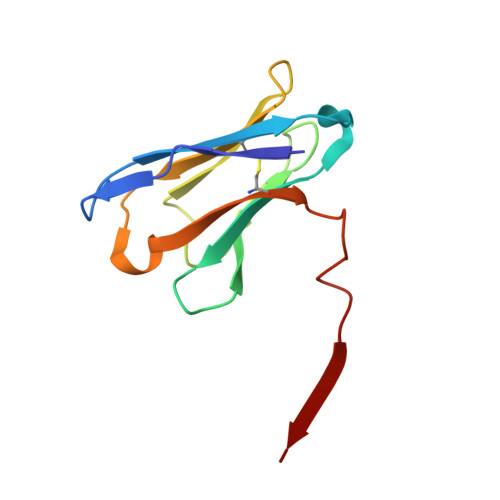General strategy for the generation of human antibody variable domains with increased aggregation resistance
Dudgeon, K., Rouet, R., Kokmeijer, I., Schofield, P., Stolp, J., Langley, D., Stock, D., Christ, D.(2012) Proc Natl Acad Sci U S A 109: 10879-10884
- PubMed: 22745168
- DOI: https://doi.org/10.1073/pnas.1202866109
- Primary Citation of Related Structures:
3UPA, 3UPC - PubMed Abstract:
The availability of stable human antibody reagents would be of considerable advantage for research, diagnostic, and therapeutic applications. Unfortunately, antibody variable heavy and light domains (V(H) and V(L)) that mediate the interaction with antigen have the propensity to aggregate. Increasing their aggregation resistance in a general manner has proven to be a difficult and persistent problem, due to the high level of sequence diversity observed in human variable domains and the requirement to maintain antigen binding. Here we outline such an approach. By using phage display we identified specific positions that clustered in the antigen binding site (28, 30-33, 35 in V(H) and 24, 49-53, 56 in V(L)). Introduction of aspartate or glutamate at these positions endowed superior biophysical properties (non-aggregating, well-expressed, and heat-refoldable) onto domains derived from common human germline families (V(H)3 and V(κ)1). The effects of the mutations were highly positional and independent of sequence diversity at other positions. Moreover, crystal structures of mutant V(H) and V(L) domains revealed a surprising degree of structural conservation, indicating compatibility with V(H)/V(L) pairing and antigen binding. This allowed the retrofitting of existing binders, as highlighted by the development of robust high affinity antibody fragments derived from the breast cancer therapeutic Herceptin. Our results provide a general strategy for the generation of human antibody variable domains with increased aggregation resistance.
Organizational Affiliation:
Garvan Institute of Medical Research, 384 Victoria Street, Darlinghurst, Sydney, New South Wales 2010, Australia.


















